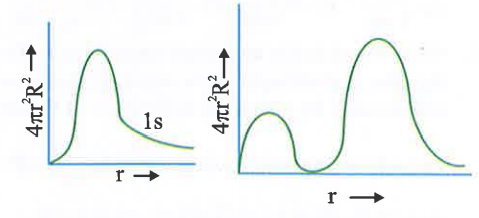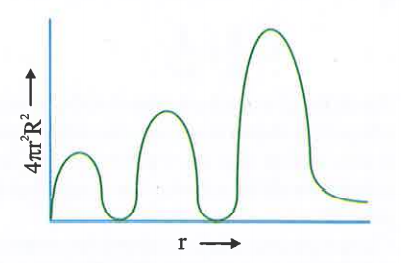Calculate total number of peaks which may appear in the radial probability curves for the following state in H atom?
Ψn,1=19√3(14π)1/2(190)3/2(6−4ra0+49r2a20)e−r/3a0
The correct Answer is:3
3
Topper's Solved these Questions
Similar Questions
The wave function of 3s and 3pz orbitals are given by :
Ψ3s=19√3(14π)1/2(Zσ0)3/2(6−6σ+σ)e−σ/2
Ψ3pz=19√6(34π)1/2(Zσ0)3/2(4−σ)σe−σ/2cos0,
σ=2Zrnα0
whereα0=1st Bohr radius , Z= charge number of nucleus, r= distance from nucleus.
From this we can conclude:
View SolutionThe wave function of 2s electron is given by
ψ2s=14√2π(1a0)3/2(2−ra0)e−ra0
It has a node at r=rp . Find the relation between rp and a.
View Solution
Knowledge Check
Given R(r)=19√3(14π)1/2(1a0)3/2(6−4ra0+49r2a20)e.r3a0
Which in INCORRECT statement about R(r ).AThe number of angular nodes is zero.BThe number of radii nodes is 2.CThe distance between radial nodes is √27a0.DThe equation represents 2s orbitalThe Schrodinger wave equation for H-atom is
∇2Ψ=8π2mh2(E−V)Ψ=0
Where ∇2=∂2∂x2+∂2∂y2+∂2∂z2
E = Total energy and V=potential energy wave function Ψ(rθϕ)R(r)Θ(θ)Φ(ϕ)
R is radial wave function which is function of ''r'' only, where r is the distance from nucleus. Θ and Φ are angular wave function. R2 is known as radial probability density and 4πr2R2dr is known as radial probability function i.e., the probability of finding the electron is spherical shell of thickness dr.
Number of radial node =n -l - 1
Number of angular node = l
For hydrogen atom, wave function for 1s and 2s-orbitals are:
Ψ1s=√1πaa0e−zr/a0
Ψ2s=(Z2a0)½(1−Zra0)e−Zra0
The plot of radial probability function 4πr2R2 aganist r will be:

Answer the following questions:
The following graph is plotted for ns-orbitals

The value of 'n' will be:A1B2C3D4The wave function of 3s and 3pz orbitals are given by :
Ψ3s=19√3(14π)1/2(Zσ0)3/2(6=6σ+σ)e−σ/2
Ψ3sz=19√6(34π)1/2(Zσ0)3/2(4−σ)σe−σ/2cos0,
σ=2Zrnα0
whereα0=1st Bohr radius , Z= charge number of nucleus, r= distance from nucleus.
From this we can conclude:ATotal number of nodal surface is same for 3s and 3px orbitalsBThe angular nodal surface of 3pz orbital occur at 0=π2CThe radial nodal surface of 3s and 3pz orbitals are at equal distance from nucleus.D3s electrons have greater penetrating power into the nucleus compared to 3pz electron.
The wave function of 2s electron is given by
W2s=14√2π(1a0)3/2(2−ra0)e−1a0
It has a node at r=rp .Find the radiation between rp and a
View SolutionConsider ψ (wave function) of 2s atomic orbital of H-atom is-
ψ2s=14√2πa3/20[2−ra0]e.r2a0
Find distance of radial node from nucleous in terms of a0
View SolutionThe Wave function (Ψ) of 2s is given by:
Ψ2s=12√2π(1a0)1/2{2−ra0}e−r/2a0
At r=r0, radial node is formed . Thus for 2s ,r0, in terms of a0 is-
View SolutionThe Wave function (Psi) of 2s is given by:
Ψ2s=12√2π(1a0)1/2{2−ra0}e−r/2a0
At r=r0, radial node is formed . Thus for 2s ,r0, in terms of a0 is-
View SolutionConsider ψ (wave function) of 2s atomic orbital of H-atom is-
ψ2s=14√2πa3/20[2−ra0]e.r2a0
Find distance of radial node from nucleous in terms of a0
View Solution
